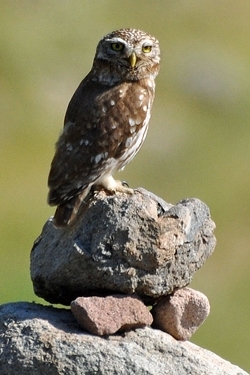Little owl
 This diminutive owl can be found across Europe, Asia and North Africa. However, it is not native to this country, having been introduced to the UK in the late 1800s by landowners who thought that the species would be a useful addition to our native bird list. Interestingly, the first few attempts were unsuccessful, but a series of releases that took place at Stonewall Park, near Edenbridge in Kent, finally saw the little owl (Athene noctua) become established, with the first successful breeding recorded in 1879.
This diminutive owl can be found across Europe, Asia and North Africa. However, it is not native to this country, having been introduced to the UK in the late 1800s by landowners who thought that the species would be a useful addition to our native bird list. Interestingly, the first few attempts were unsuccessful, but a series of releases that took place at Stonewall Park, near Edenbridge in Kent, finally saw the little owl (Athene noctua) become established, with the first successful breeding recorded in 1879.
More releases elsewhere in Britain, especially in Northamptonshire in the late 1880s, helped to further establish the little owl as breeding species, and it can now be found across the whole of England and Wales, with a few records in southern Scotland too. There’s now an estimated 5,600 pairs in the UK, with their favourite areas being East Anglia, the Midlands and North West England.
The UK’s little owl population is, however, now in decline, with data showing that the numbers have shrunk by 65% over a 25-year period. There has also been an 11% contraction in its UK range, especially apparent in South West England and Wales.
Little owls prefer to live in places that offer a number of mixed habitats in a smallish area. They like lowland farmland, especially with permanent pasture and livestock present. I find that they particularly like parkland with mature trees, including some of our busy urban parks. Country villages quite often offer this patchwork quilt of mixed habitats too, with large gardens, mature trees and horse paddocks making up an ideal scenario for them to find earthworms, beetles, moths, spiders, small mammals and the occasional bird.
Little owls can often be observed perched on dead tree branches, fence posts, telegraph poles and the rooftops of outbuildings. They can be seen throughout the day (although they are most active during the periods of dawn and dusk), especially during the late spring and summer breeding season, when they have hungry chicks to feed. Little owls are very partial to sunbathing, particularly first thing in the morning, when they can often be located dozing in a choice spot that captures the early rays of sunlight.
Should you come across one, you will immediately notice its huge yellow eyes with their large, black, piercing pupils staring back at you! It will probably bob its head up and down too, seemingly weighing up all possibilities, before eventually taking flight with its large, rounded wings and rapid wingbeats.
One quirky little story that is often told in connection with little owls is that they can occasionally be seen to fall over backwards, when suddenly succeeding in extracting a large earthworm from its burrow! This seems rather odd for an owl that is dedicated to Pallas Athene, the Greek goddess of wisdom!
Peter Thompson
Advisory
Read more from Peter Thompson at his blog.

Download Peter Thompson's essential 26-page book, featuring beautiful photography and detailed profiles of Britain's wildlife
Download FREE >